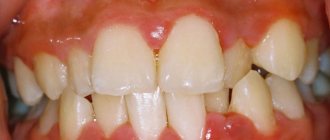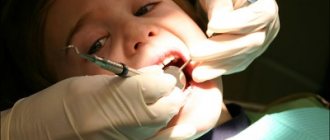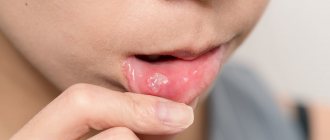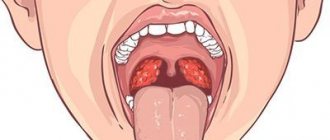The problem occurs several weeks before the eruption of a baby or permanent tooth. The appearance of a cyst is indicated by a bluish-purple spot (hematoma). This is due to difficulty in tooth eruption.
An eruption cyst is a type of soft tissue benign tumor that appears when a tooth has already begun to erupt through the gum. Scientists and doctors have not agreed on why it occurs. The most likely causes: infection, trauma, improper development of teeth, which causes a lack of space for the “newbie”. In addition, it may be a consequence of caries and improper care.
Eruption cysts occur during the growth of baby teeth or, more often, at 6–9 years of age, when permanent teeth emerge. The fact is that, due to its anatomical structure and location, the chewing group of teeth is the most difficult to erupt.
If you notice a large formation in your baby’s mouth, in the place where a tooth should appear, consult a doctor. Do not resort to self-medication under any circumstances. Infusions, rinses and even strong antibiotics most likely will not help, but ruining a child’s health in this way will cause serious harm.
If you contact a specialist, treatment can follow one of two scenarios. In the most favorable option, the doctor will advise giving the child toys, special teethers, crackers - everything that the baby can chew. This will help break through the mucous membrane.
In difficult situations, surgery may be necessary. Then the surgeon will cut the gum under local anesthesia. This will make teething easier.
It is forbidden to try to cut or tear the mucous membrane on your own; you can cause a serious infection or injure your baby.
Causes of Teething Cysts in Children
During teething, a hematoma is formed; it occurs due to the fact that the tooth cannot break through the mucous membrane and thereby injures the gums and ruptures blood vessels. The longer the formation is in the oral cavity, the larger its size; in addition, the amount of swelling will depend on the group affiliation of the tooth.
The main causes of the tumor:
- pulpitis;
- caries;
- periodontitis;
- improper tooth treatment or lack thereof;
- eruption injuries.
The baby’s body tries to limit the source of infection, which is why a dense protective capsule is formed, which eventually develops into a cyst. The occurrence of such formations is quite common. An infection caused by carelessness, an unsuccessful attempt to chew hard food, a fall that led to a tooth injury - all this can serve as a starting point for gum inflammation and further development of a cyst.
Another fairly common mistake parents make, which can lead to the appearance of a tumor during teething, is negligence in caring for baby teeth.
It is generally believed that you should take serious care of your dental health after changing them. Since there is no point in treating non-permanent baby teeth - they will soon fall out. In fact, not taking things seriously leads to many problems. Any gum diseases and oral infections should be eliminated in a timely manner, regardless of how many teeth the baby has and whether they are permanent or not.
What to do if a child has a lump on his gum near a tooth?
A lump on a child’s gum can have a different appearance, which is well demonstrated by the selection of photos. With such a problem, you should definitely consult a doctor. Self-medication is strictly prohibited. This can only aggravate the pathological process.
The specialists of the Shifa dental clinic will help you understand the causes of compaction on the gums and provide qualified assistance in full. In the clinic, all dental procedures are performed under anesthesia, so the child will not experience negative emotions during treatment. Contact the best dentists! You can make an appointment at the Shifa clinic by phone or through the form on the website.
Complications with cyst growth
Tooth trauma, advanced caries, nasopharyngeal or periodontal disease, dental malformations - one or more of these factors can lead to the development of a cyst. The danger is that the cyst grows unnoticed. It usually does not hurt and at the initial stage does not cause discomfort or reaction of the lymph nodes. With further development, suppuration and various unpleasant sensations may appear. But even if there is no pus, the cyst is very dangerous. Therefore, do not delay treatment.
A cyst can lead to intoxication of the body due to the fact that waste products of harmful microorganisms enter the blood. The consequence of this can be headaches, high fever and, in the worst case, sepsis.
In addition, complications are caused by local problems - phlegmon, abscesses, osteomyelitis. These complications are inflammatory in nature and often occur when the cyst suppurates. The spread of pus can lead to destruction of the jaw bones, damage to the internal organs of the digestive system, liver, and heart.
It is impossible to avoid the appearance of a cyst, but if you properly care for baby and permanent teeth and treat infections in a timely manner, you can reduce the likelihood of its occurrence. In addition, periodic visits to the dentist will allow you to notice the problem at an early stage, when treatment will be as simple and easy as possible for the body.
Causes
The cyst appears as a tumor under the cheekbone, protruding from the outside. If left untreated, inflammatory processes appear, which can lead to the formation of an abscess or phlegmon. The pathology is a rare formation, usually diagnosed before the age of thirty. Place of development - on the lips, cheeks, palate, less often - in the sublingual ducts. Very rare is the pathology of the glands that develops in the parotid and mandibular areas.
The causes of this pathology are:
- injuries, wounds of the mucous membrane;
- mucus plugs that appear in the ducts;
- stomatitis and other inflammatory processes leading to obstruction;
- formation of salivary stones;
- pressure on the ducts;
- scar type narrowing.
Causes also include developmental defects, genetic predisposition, and damage to certain tissue areas. But more often the problem develops against the background of tissue injury and inflammatory processes. Wounds are formed by frequent biting of the cheek or tongue, due to the abuse of rough, spicy food, and hot dishes. In addition, such injuries can cause gland atrophy, so they cannot be ignored.
Cyst treatment
A dental cyst is treated either with therapeutic methods or with surgical intervention. The first ones are used in simple cases.
Surgery involves two types of operations - cystotomy and cystectomy. In both cases, local anesthesia is used. With cystomy, only the anterior wall of the cyst is removed. This is a less traumatic option, as it allows you to preserve the rudiments of permanent teeth during surgery on milk teeth.
Cystectomy is performed if the size of the cyst does not exceed 1.5 cm. This operation is more difficult, but postoperative recovery is much faster.
No matter how small and insignificant the swelling may seem to you, contact your dentist. This will avoid complications. And the problem will be resolved more easily and in a short time. Remember that no rinses, infusions or other folk remedies can guarantee recovery.
Purulent lump
The main reasons for the development of pustules on the gums:
- The most important factor that leads to the formation of a purulent lump or gumboil is periodontitis, which develops as a result of untreated caries. In this case, the size of the carious defect does not matter, and even the smallest lesion can cause a strong inflammatory reaction.
- Also, the cause of the formation of an abscess over a tooth can be an injury received from a fall or blow.
- Sometimes flux is a consequence of tissue damage from sharp objects (for example, if a child has the habit of chewing a pencil or toothpick).
Manifestations
The symptoms of this pathology are quite specific. At the initial stages of development of the purulent process, the child complains of pain and a feeling of fullness in the tooth area. At this time, a red swelling appears on the gum in the projection of the tooth root, which gradually increases in size, and pus accumulates in its center. This lump is soft to the touch and hurts when you press on it. As inflammation progresses, the formation becomes whitish and a white abscess forms.
At the same time, the general condition of the baby may suffer. Children become restless, refuse to eat, and their temperature rises.
If full treatment is not carried out at this stage, then as pus accumulates, the pressure inside the abscess increases and spontaneous opening of the white lump occurs. In this case, a fistula is formed, which connects the surface of the gums with the pathological focus. After the lump bursts, the child experiences relief of symptoms: pain decreases.
As the inflammatory process subsides, the fistulas can close on their own, but this does not mean that recovery has occurred, since the pathological focus itself remains unsanitized. With a decrease in the protective properties of the body, the disease can be activated with the reappearance of an abscess and fistulas.
Treatment
If a purulent lump is detected in the child’s mouth, it is necessary to contact the dentist as early as possible.
If the cause of the formation of an abscess or fistula is a baby tooth, then treatment will be reduced to its urgent removal. It is impossible to leave such a tooth, since the preservation of even a slight focus of inflammation can lead to the death of the permanent tooth germ.
If flux has formed over a molar, then all therapeutic measures will be aimed at preserving it. In this case, the dentist will open the lump, clean the cavity from purulent masses and treat it with an antiseptic. Removing a permanent tooth is a last resort and is carried out only when there is significant destruction.
Complications
Despite the fact that purulent bumps are rarely large, their complications can be extremely serious and dangerous.
- The death of the rudiments of permanent teeth leads to edentia. Such a condition in childhood can cause improper development of the maxillofacial apparatus and bite pathology, which will require serious orthodontic treatment in the future.
- Chronic purulent lesions and fistulas in the oral cavity are a source of infection, which can spread and cause inflammation in other organs: tonsils or adenoids.
- The constant inflammatory process changes the activity of the immune system, which becomes more sensitive to the effects of various allergens. In this case, the child may develop hypersensitivity reactions even to those substances to which allergies were not previously observed.
- If the abscess does not open outward, then the pus can spread deep into the tissues with the formation of phlegmon - a severe complication that is life-threatening.
Memo to parents
If you find a purulent lump in your child, then you need to remember several important nuances:
- It is strictly forbidden to try to open an abscess on your own. This can lead to pus entering the bloodstream and the development of sepsis - blood poisoning.
- You cannot carry out any warming procedures: apply compresses or rinse your mouth with hot liquid. This will only worsen the inflammation.
- Cold can be applied externally to the cheek in the area of the lump; this will somewhat alleviate the symptoms and slow down the development of the abscess.
- At the first symptoms of gumboil, you should contact your pediatric dentist for professional treatment.
How to avoid complications
To avoid missing a cyst in the early stages, check with your dentist at least once every six months, especially if your child has chronic pulpitis or periodontitis. The occurrence of cysts is most likely between the ages of 6 and 12 years, especially during the formation of the first molars in the lower jaw.
Teach your child proper and regular oral hygiene. This will reduce the likelihood of inflammation and caries in both milk and permanent teeth. For this, use high-quality children's toothpaste for a specific age. Asepta has developed Baby, Kids and Teens pastes that take into account the dental needs of children of different ages. For the little ones, specialized Asepta wet wipes designed in the form of finger pads are suitable - wipe the gums after each feeding.
It is necessary to treat infections and caries in a timely manner so that they do not lead to the formation of a cyst in the future.
Summary:
You should not think that if a purulent cyst on the gum spontaneously opens, then you don’t need to go to the dentist and not treat the causative tooth. The source of inflammation at the root tip will still be in place, and it will slowly increase. Over time, this can lead to the formation of a large root cyst at the apex of the tooth root, and even tooth extraction. Therefore, treatment should not be delayed. We hope that our article: Cyst is not a gum treatment - was useful to you.
Sources:
1. Higher prof. the author’s education in therapeutic and surgical dentistry, 2. Based on personal experience as a dentist, 3. National Library of Medicine (USA), 4. “Outpatient surgical dentistry” (Bezrukov V.), 5. “Therapeutic dentistry: Textbook” (Borovsky E.).











